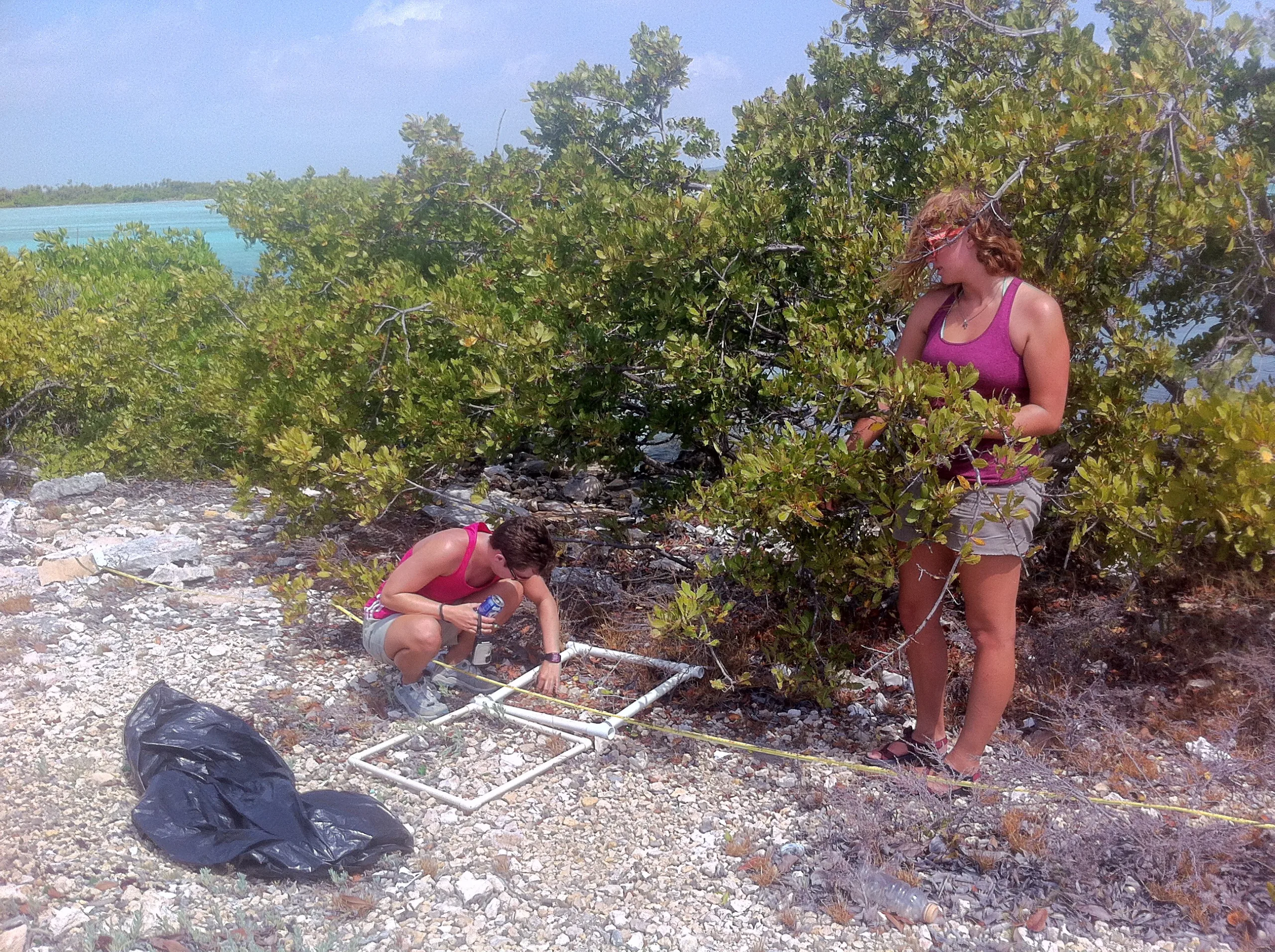Island-Focused Research Turns Landward
As in semesters past, the Spring 2015 SFS semester on South Caicos placed a heavy focus on the coral reef community that sits just a short distance from the (indoor) classroom at the Center for Marine Resource Studies (CMRS). Student-led projects continued to expand our knowledge on queen conch, Caribbean spiny lobster, several species of sharks and reef fish, and the coral community that forms the foundation of this ecologically and socioeconomically important ecosystem. The Center also remained committed to building inroads that improve our understanding of the island’s terrestrial environment and community by kicking off a new study targeting the production and management of solid waste in South Caicos.

Island communities are known to have a number of vexing environmental concerns that prove stubborn to resolve because of their limited number of resources and space, and the demands placed on those resources. For South Caicos, one of the island’s most pressing issues is managing solid waste. Marine debris dumped from neighboring islands or passing vessels arrives and piles up on her shores, garbage is littered about after being shredded by the island’s feral animal population in their search for scraps of leftover food, and evidence of indiscriminate dumping of garbage can be seen both in and out of the town of Cockburn Harbour. Managing the life of solid wastes is an important ecological, economic, and social issue for the island. Reliant on prepackaged goods shipped in easily disposable plastic and metal containers, South Caicos’ battle with garbage is being waged every day. To help understand the scope of this problem, SFS students embarked on a baseline characterization of garbage production and management across the whole of the South Caicos community, focusing in on the town of Cockburn Harbour.
An ecological examination of garbage around South Caicos found that marine debris is largely composed of heavy, industrial-type plastics, particularly oil containers, plastic bottles, and large drums. Fishing gear, particularly tangled netting, fishing line, and line floats, are also commonly encountered. As expected, marine debris is concentrated along windward shores, suggesting that marine debris may be produced elsewhere, traveling on surface currents to South Caicos and her neighboring cays.
Conversely, litter found in and around Cockburn Harbour are consumer-grade plastics and metals like water bottles and soda cans. There is also a large amount of Styrofoam containers, commonly used by island establishments to package and carry food. This difference in the composition of marine and terrestrial debris suggests that South Caicos’ residents are themselves a source of the garbage found around the island, and their actions concerning the care, containment, and transfer of garbage to the landfill are a critical element of the problem.
Building upon this observation, a second study modeled socioeconomic incentives to manage residential and commercial waste on South Caicos. SFS students completed a census of every waste storage location in Cockburn Harbour, noting its construction and ability to thwart animal scavenging. From this, a behavior model was developed that measured human behavior in terms of “indifference”, an innovative metric that seeks to quantify the threshold that an environmental situation must pass before an individual opts to respond and attempt to address the situation. Indifference was calculated by regressing the construction and maintenance of garbage against their fullness. They found that those pens that were well constructed and maintained tended to have the lowest amount of garbage present. Taken together, these variables represent a high energy expenditure, and therefore represent a low threshold of indifference.
Indifference does not ascribe judgment values on individuals or their willingness to dispose their wastes properly. Instead, it reflects a calculation that individuals each make in determining the scale of the issue and how much they are affected. For example, a small spill of water might be quickly wiped up by an individual, reflecting a low indifference to responding to the spill. But if the spill was not a small amount of water but a very large amount of toxic paint, an individual might decide that their best course of action is to not act, measured as having a high level of indifference. In the case of garbage production, containment, and disposal on South Caicos, the visible evidence that the island has a major litter issue is everywhere. As a result, the effort required to tackle the problem is great, and concerted efforts at both the community and household level are required, if progress is to be made. As seen in the census, there is a dramatic range in household behaviors.
SFS researchers discovered that “high indifference” behaviors have a high expectation of timely garbage collection by the government agency, and should collection be delayed or cancelled, the likelihood of bags being torn and garbage being strewn about increase tremendously. “Low indifference” behaviors are also seen, with home owners taking a much more active approach in how their garbage is stored and removed from their property. With well-constructed garbage pens that not only prevent scavenging, but also physically hide the house’s wastes from public view, some individuals reduce the risk of scavenging and also limit the amount of garbage that might collect on their property. Others are even more vigilant, not waiting for the garbage collectors to make their weekly rounds, instead taking their waste to the landfill themselves.
The research into how garbage is produced and managed in South Caicos will help local stakeholders and managers better understand both the scale of the issue and potential solutions by developing tools that lower household indifference, and therefore reduce the scope and intensity of uncontained litter. Going forward, CMRS is hoping to develop partnerships within the community to construct and place garbage pens through freely available materials found on island. By reducing the numbers of poorly maintained pens, South Caicos will begin tackling the pervasive litter problem befouling their island’s beauty and potentially risking their economic future.

Related Posts


Alumni Reflections: Stories of the Return to Kenya
